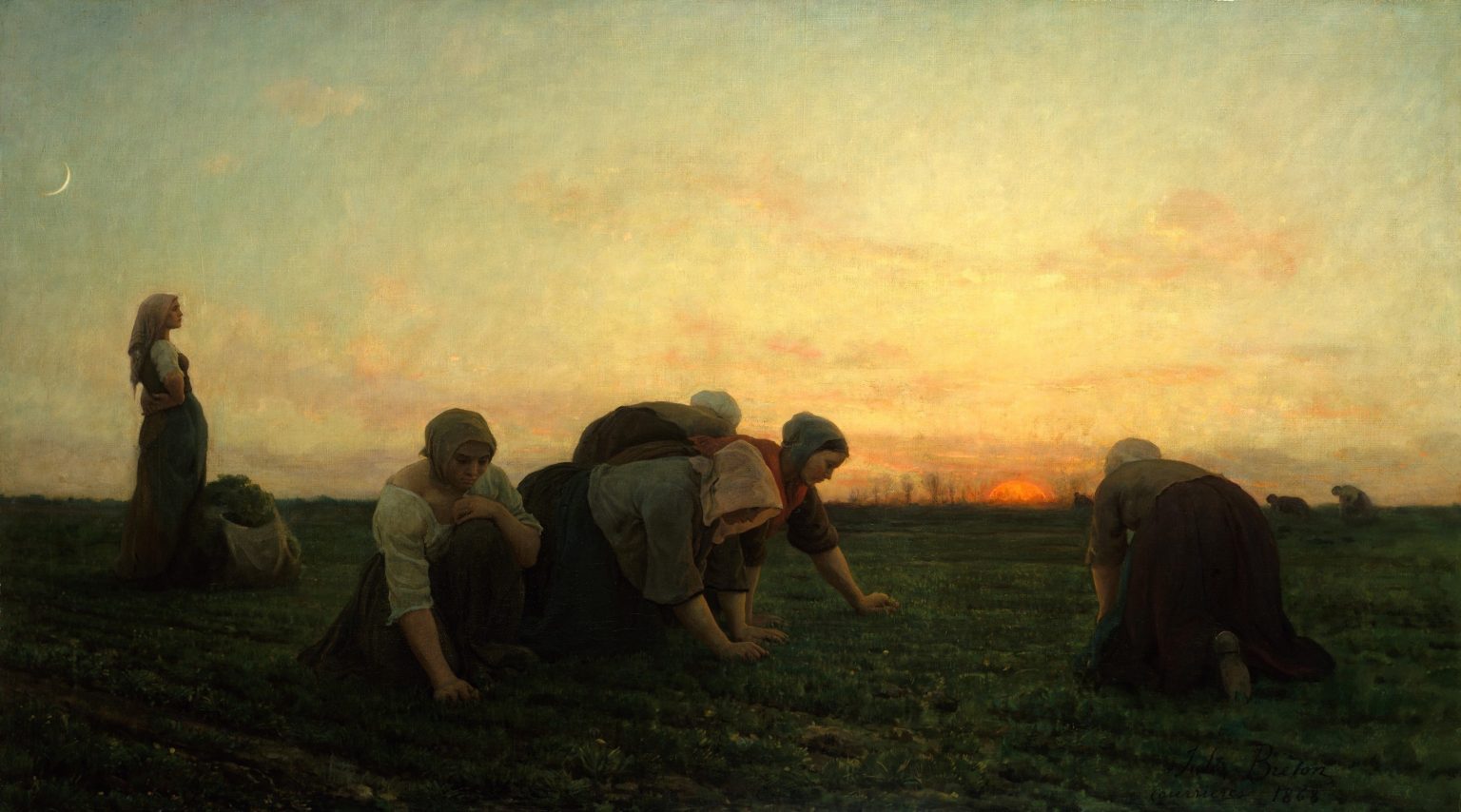Introduction:
In the realm of 19th-century French art, few names resonate with the essence of rural life and the human condition as profoundly as Jules Adolphe Aimé Louis Breton. A master of Realism, Breton’s artworks transport viewers to the serene landscapes and humble existences of rural France. Through his precise brushwork and keen observation, Breton immortalized the beauty, struggles, and dignity of peasant life. Let us delve into the captivating world of Jules Breton’s realism artworks, where each canvas tells a poignant story of human experience.
The Realist Movement:
Born on May 1, 1827, in Courrières, France, Jules Breton grew up amidst the pastoral landscapes of northern France. Inspired by the works of Gustave Courbet and Jean-François Millet, Breton became a leading figure in the Realist movement—a movement that sought to depict everyday life with uncompromising accuracy. Realist artists rejected the idealized portrayals of historical or mythological subjects, opting instead to focus on the lives of ordinary people.
Breton’s Realism:
Breton’s commitment to depicting the realities of rural life is evident in his body of work. His paintings often feature peasants engaged in everyday activities such as harvesting, tending to livestock, or resting after a day’s toil. One of his most renowned works, “The Gleaners,” captures the arduous task of gathering leftover crops from the fields—a scene emblematic of the hardships endured by rural communities.
Another hallmark of Breton’s realism is his meticulous attention to detail. Whether it be the texture of a weathered barn door, the play of light on a dewy meadow, or the weather-beaten faces of his subjects, Breton’s paintings are imbued with an unparalleled sense of authenticity. His mastery of light and shadow adds depth and dimension to his compositions, drawing viewers into the bucolic landscapes he so expertly renders.
Themes of Labor and Dignity:
Central to Breton’s oeuvre is the theme of labor and its inherent dignity. Through his paintings, he pays homage to the resilience and fortitude of the rural poor, whose lives revolve around the rhythms of the land. In “The Weeders,” Breton depicts a group of women stooped over in the fields, their backs bent under the weight of their labor. Yet, despite their toil, there is a sense of quiet dignity in their posture—a testament to the strength of the human spirit in the face of adversity.
Similarly, in “The End of the Working Day,” Breton portrays a weary farmer returning home after a day in the fields. The setting sun bathes the landscape in a warm glow, casting long shadows across the path. Yet, amidst the tranquility of the countryside, there is an underlying sense of fatigue and resignation—a reminder of the physical toll exacted by a life of labor.
Social Commentary:
While Breton’s paintings celebrate the beauty of rural life, they also serve as a form of social commentary. At a time of rapid industrialization and urbanization, Breton’s work offered a counterpoint to the burgeoning modernity of the era. His paintings served as a reminder of the agrarian roots upon which French society was built, and a plea for the preservation of rural traditions in the face of encroaching modernity.
In “The Song of the Lark,” Breton presents a poignant contrast between the idyllic countryside and the encroaching industrial landscape on the horizon. A lone peasant girl stands amidst a field of golden wheat, her face upturned in song. Yet, looming in the distance are the smokestacks of factories—a stark reminder of the encroachment of industrialization on the rural way of life.
“The Song of the Lark” stands as one of Jules Breton’s most iconic works, embodying the essence of his Realist vision. In this painting, Breton transports viewers to the tranquil fields of rural France, where a lone peasant girl stands amidst a sea of golden wheat. Her face, upturned towards the heavens, exudes a sense of serenity as she unleashes a melodious song—a poignant ode to the beauty of the natural world. Against the backdrop of rolling hills and a vast expanse of sky, the girl’s solitary figure becomes a symbol of resilience and hope in the face of encroaching industrialization.
For those eager to delve deeper into the enduring legacy of “The Song of the Lark,” reproductions of this masterpiece offer an immersive experience. Each brushstroke and nuance of light is faithfully recreated, allowing viewers to bring a piece of Breton’s rural idyll into their own homes. Whether adorning the walls of a gallery or gracing a private collection, reproductions of “The Song of the Lark” serve as a timeless reminder of the enduring power of art to uplift the human spirit and inspire contemplation of life’s beauty and simplicity. Learn more here about the reproduction of this painting.
Legacy:
Jules Breton’s legacy extends far beyond the confines of his canvas. His influence on the Realist movement paved the way for future generations of artists to explore themes of social realism and the human condition. His paintings continue to captivate audiences around the world, offering a timeless glimpse into the vanishing world of rural France.
In conclusion, Jules Adolphe Aimé Louis Breton stands as a towering figure in the annals of art history—a master of Realism whose paintings capture the essence of rural life with unparalleled clarity and compassion. Through his keen observation and profound empathy, Breton immortalized the beauty, struggles, and dignity of the peasant class, leaving behind a legacy that continues to inspire and resonate to this day.



